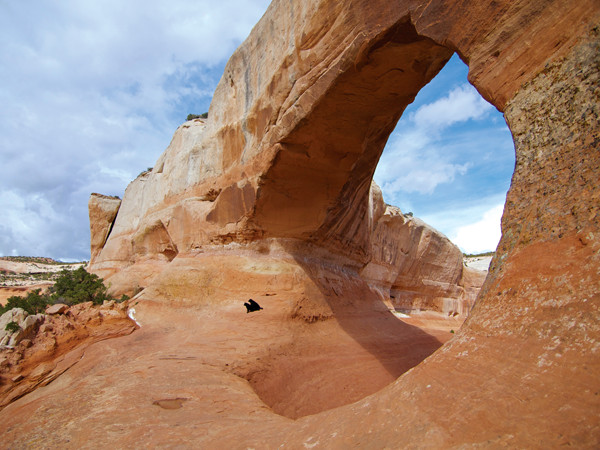
by Mary Caperton Morton Tuesday, November 4, 2014

New research suggests that the formation of sandstone arches, such as Wilson Arch just south of La Sal Junction, depends on gravity. Credit: Mary Caperton Morton.
Every visitor to Arches National Park in Utah wonders how the spectacular, seemingly improbable sandstone arches form, but although there are many hypotheses, testing different ideas in the field has proved all but impossible. Now a new modeling study suggests that while arches may seem to defy gravity, their formation actually depends on it.
“There are many different theories on how sandstone landforms evolve, but very little strong proof in support of one idea or another,” says Jiří Bruthans, a hydrogeologist at the Charles University in Prague, Czech Republic, and lead author of the new study, published in Nature Geoscience.
After noticing short-lived pillars and arches forming in crumbly sandstone at a rock and sand quarry in the Czech Republic, Bruthans and colleagues seized the opportunity to study the process of arch and pillar formation in the lab, where the loosely lithified quarry sandstone could erode into a variety of formations in a matter of minutes, as opposed to millions of years.
When they subjected small blocks of the Czech sandstone to different erosive scenarios, including simulated wind and rain, the samples quickly fell apart. But if they placed weights on top of the samples before eroding them, the weights helped pack the sand grains together and the blocks readily formed into pillars and other shapes.
Further modeling revealed a feedback cycle between erosion and stress, where the removal of grains led to greater stress on the remaining rock, which served to cement the grains more tightly together, supporting the shape. Eventually, the blocks reached a critical point where the sand grains locked together and became “incredibly stable,” Bruthans says. Different erosive models produced a variety of landform shapes, including arches, alcoves, pedestals and pillars.
The idea that the force of gravity helps build the interior scaffolding needed to form sandstone landforms is a departure from one of the leading theories of arch formation, Bruthans says. “Engineering geologists usually only consider stress as a destructive factor: Stress increases until a critical point and then the landform fails,” he says. The idea that vertical stresses could actually aid in the formation of such structures is not completely new — it has been proposed by other researchers in the past — but Bruthans’ team is the first to test the idea in the lab.
“The idea presented in this paper is really quite simple and elegant,” says Chris Paola, a sedimentary geologist at the University of Minnesota who was not involved in the new study but wrote an accompanying commentary in Nature Geoscience. The idea also runs counter to another popular theory of arch formation, which holds that the arch shape is already present within a block of rock and that erosion simply reveals it over time, Paola says, “like developing a photograph. But [Bruthans’ study] shows that there’s no need for any pre-existing form; the shape emerges as a result of local interactions between the grains. It’s a fascinating example of a self-organizing principle at work.”
The idea that stress helps shape sandstone landforms is appealing in its simplicity, but many questions remain about how different shapes emerge, Paola says. “There’s not much detail in their paper about what factors lead to one shape or another, although in most self-organization models the final outcome is often very sensitive to small changes in initial conditions,” he says.
Bruthans says that his team’s findings should apply to most types of sandstone, not just the samples from the Czech quarry, and even some other types of rock like granite and quartzite that display similar characteristics of locking grains and cementation. Testing the theory in the field, however, will be difficult for a number of reasons. For example, “in natural exposures you never know if the form is presently still evolving and whether the conditions and processes operating now are those that originally created the form,” Bruthans says.
Fortunately, the modeling is simple enough that it should be easily replicated in other labs, Paola says. “This is a very clear, nicely defined idea and it shouldn’t be hard to figure out if it’s right or wrong,” he says. “It’s exciting to think that these formations could come about through a series of simple, local processes from which this beautiful landform emerges.”
© 2008-2021. All rights reserved. Any copying, redistribution or retransmission of any of the contents of this service without the expressed written permission of the American Geosciences Institute is expressly prohibited. Click here for all copyright requests.